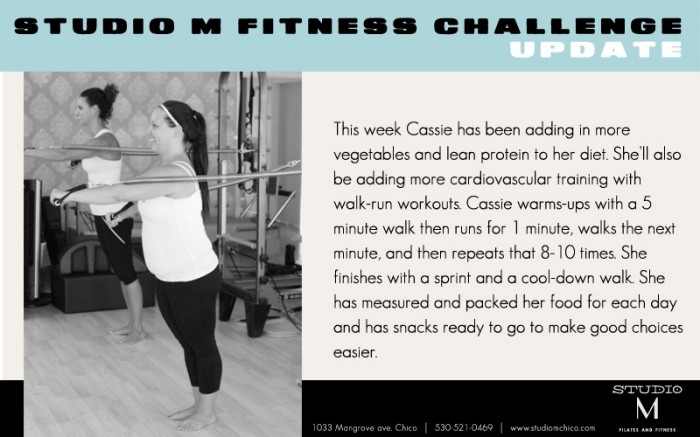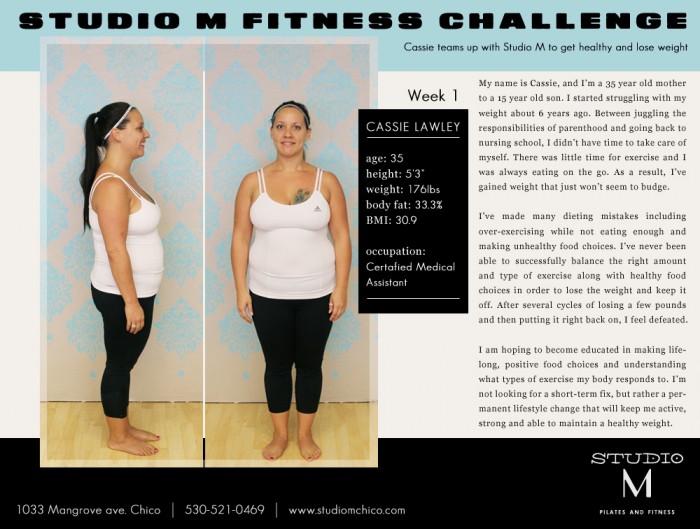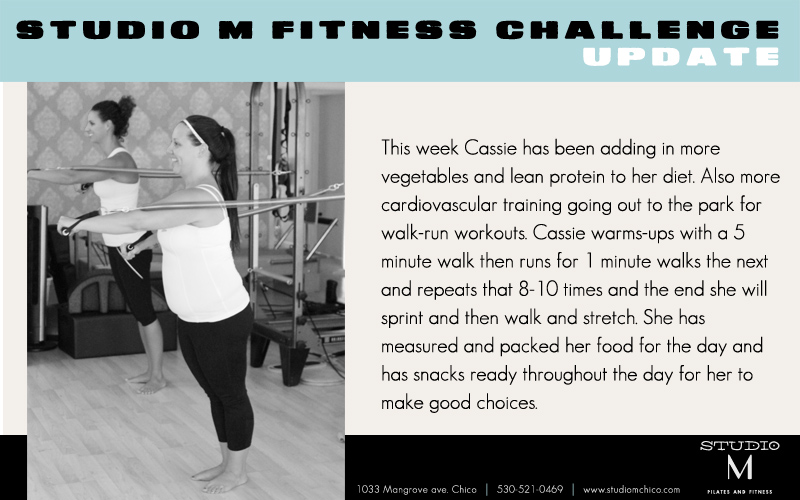

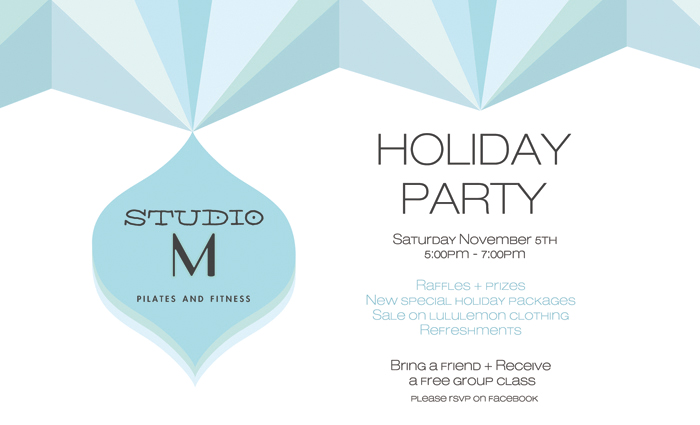
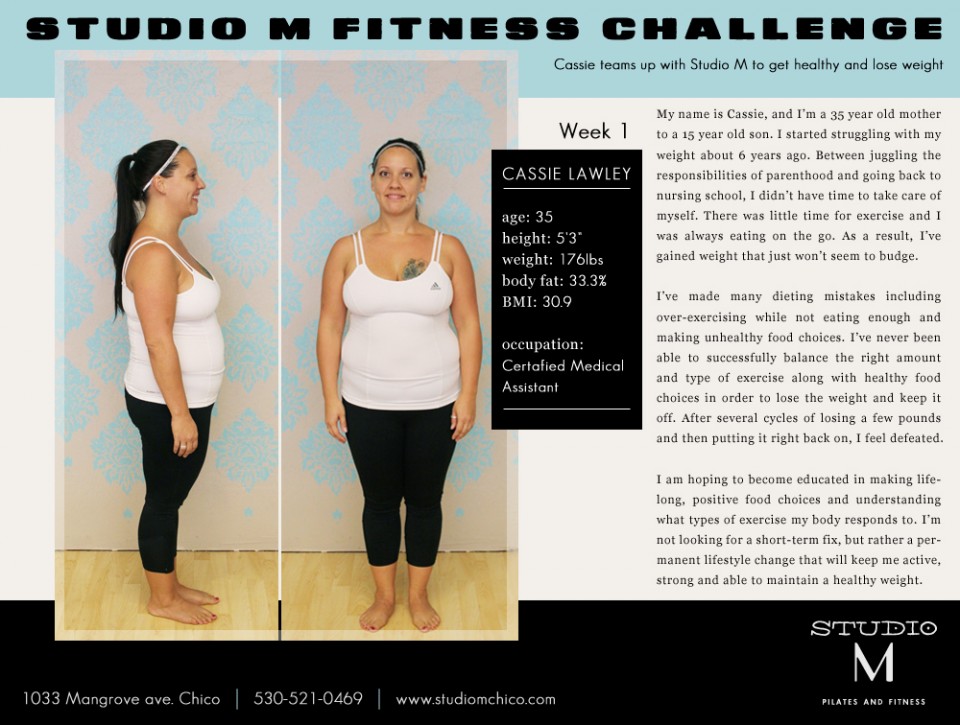
Studio M Fitness Challenge: Cassie Week 1
Cassie teams up with Studio M to lose weight and get healthy! Follow her amazing progress!

How do you know if you are at a healthy weight for your body?
How do you know if you are at a healthy weight for your body? or what that might be?
You’ve seen the ads: “Lose 20 pounds in 30 days!,” “Eat whatever you want and lose weight.” If you haven’t already figured it out, fad diets and nutritional gimmicks are not the way to achieve a healthy weight and keep it for the long haul.
Running is a great calorie-burner–depending on your weight, you expend roughly 100 calories per mile–but many women start running to lose weight and get frustrated when the pounds don’t melt away. That’s because exercise alone doesn’t lead to successful weight loss. It’s better to aim for a lean, healthy body through a combination of fitness training and smart eating habits. Here’s the complete guide to achieving and maintaining a healthy weight, without the gimmicks.
Find Your Healthy Weight
Before starting to lose weight, make sure you really need to. Dr. Carol Otis, author of The Athletic Women’s Survival Guide and a sports medicine physician, stresses there isn’t a perfect formula to determine a woman’s correct weight, because every body is so unique.
“No tables exist for listing the weight you should be, and there’s no specific number on the scale you should aim for,” she says. “Your age, height, hormonal status and the thickness of your bones, as well as your body type–factors that are genetically predetermined and not under your control–affect your weight, including the ease at which you lose body fat and build muscle.”
Be honest about what you hope losing weight will do for you. Don’t assume your performance will automatically improve, especially if your body fat is already at a reasonable level.
According to the American College of Sports Medicine, no additional benefits to sport performance occur when body fat drops below 16 percent for women under age 55 (20 percent for those over 55), but health risks such as eating disorders, osteopenia and other health problems related to poor energy and nutrient intake increase.
Most female runners reach and maintain a leaner weight only after they develop a more positive body image. Disordered eating (erratic eating habits such as “forgetting” to eat, being compulsive about only eating nonfat foods or eliminating entire groups of foods) driven by body dissatisfaction is an indication you struggle with respecting your body.
A Ball State University and Arizona State University study found as many as 72 percent of female athletes do not eat enough to sustain them, taking in 1,500 calories or fewer when they likely need 2,700 to 3,000 calories a day.
“The scale is either a tool or a weapon,” says Emily Edison, a sports dietitian and certified fitness trainer in Seattle who works with the University of Washington’s NCAA women’s cross country team. “Use it, if at all, only as an occasional check, and not to measure self worth.”
To find the weight that’s healthiest for you, first assess your daily caloric needs. Based on your exercise level, the following formulas (for both women and men) give a ballpark estimate. The moderately active to very active range means you consistently train or work out at moderate or higher intensity five to six days per week. Most active females should use the lower-to-mid ranges:
Less active (20 to 30 minutes two to four times a week): Body weight in pounds x 13.5 to 15 calories = daily calories
Light to moderately active (45 to 60 minutes a day of purposeful moderate intensity exercise, most days of the week): Body weight in pounds x 16 to 20 calories = daily calories
Very active (60 to 120 minutes or more 5 to 6 days a week): Body weight x 21 to 25 calories = daily calories.
Whether you maintain, gain, or lose weight is a matter of energy balance. To lose a pound, you must create a deficit of 3,500 calories–by eating less, moving more or preferably, a combination of the two. Slashing 500 calories a day to lose a pound per week is too much for most female runners, who end up consuming too few of the nutrients needed for good health and performance. Trimming 200 to 300 calories a day is more realistic.
Make Your Calories Count
You have to eat in a way that allows you to train well both physically and mentally, says Edison. This type of diet, often referred to as high-performance eating, prepares your body for exercise without loading it down with unnecessary calories.
High-performance eating leaves you physically and mentally prepared to exercise, and it’s not just for elite athletes or those planning to run a marathon. It’s a common misperception that high-performance eating leads to weight gain, but it won’t if done properly.
It’s crucial to get balance and variety from a wide selection of foods. Figuring out exact percentages of carbohydrate, protein and fat isn’t necessary. In fact, even the U.S. Department of Agriculture has realized one-size-fits-all diets don’t work. Its 2005 dietary guidelines (available at mypyramid.gov) include 12 versions of the food pyramid, each slightly different, depending on a person’s age, sex and level of physical activity.
In general, you should aim to eat enough fruit, vegetable, protein and grain servings every day to fuel your active lifestyle. Female runners need at least two cups of fruit, three cups of vegetables, six ounces of grains (make at least three servings whole grains), three servings of dairy, six ounces of meat or the equivalent from beans/ eggs and soy foods, and a minimum of 25 to 30 grams of fat (five to six teaspoons) daily.
“Eating to fuel yourself adequately not only enhances your running performance,” says Edison, “it’s the best path to a leaner, stronger body.”
At every meal, eat lean protein-rich foods. Besides being nutritional powerhouses, foods like eggs, fish, poultry, lean red meat, beans or soy and low-fat dairy help sustain a steady blood sugar level, which decreases the desire to snack every hour or two.
Also include healthy fats like avocados, nuts and nut butters, seeds and low-fat salad dressings as they help quell cravings that can spiral into binge eating. Eat fruits and vegetables daily to get the antioxidants you need to repair exercise-induced damage.
Dr. Barbara Rolls, a nutrition researcher at Pennsylvania State University and the author of The Volumetrics Eating Plan, found the nutrient density of the foods is key to feeling satisfied sooner. As a general guideline, the higher the moisture content of a given food, the lower its energy density.
In other words, you can eat more of it–a satisfying portion–for a very reasonable amount of calories. You’ll also feel fuller for longer after consuming it. Rolls found if you begin a meal with either a salad or soup, you’re more likely to consume fewer calories during the meal.
Use sports foods wisely–sports drinks, gels and energy bars serve a real purpose when used to supplement carbohydrate and energy needs; otherwise, skip them. It only takes 100 extra calories a day to gain 10 pounds in a year. That’s one high-calorie pre-run snack or bottle of sports drink you didn’t need.
Plan to eat every few hours during the day– three balanced meals and two to three snacks daily–and coordinate meals with your running schedule so you’re fueled before you go and to speed recovery afterward. Otherwise, losing weight healthfully and keeping it off is impossible.
And don’t forget to build in a few “fun” foods. We eat sweets, treats and salty snack foods because they taste good, not for their nutritional value. Allow yourself a few treats in moderation so you don’t binge.
“Eating too much pumpkin pie does not make someone a bad person,” says Edison. “So often, women feel guilty about their ‘mistakes’ with food and punish themselves, sometimes by vowing never again to eat the item. Unfortunately, this only sets you up for overdoing it again.”
Build Fitness and Muscle
In its Dietary Guidelines for Americans, the U.S. Department of Agriculture recommends 60 to 90 minutes of moderate- to vigorous-intensity exercise most days of the week if you’re trying to lose weight. Running more miles (more minutes) per week is an option, of course, but the intensity of workouts is a key variable.
Fast-paced training such as tempo runs and interval workouts builds maximum fitness and burns more calories per minute than low-intensity running or walking. For example, a 10-minute-per-mile runner who improves her fitness and becomes capable of clicking off eight-minute miles for an hour will burn almost 150 calories more per hour of running.
Spending quality time in the weight room is also important, especially if you’re over the age of 30.
“Strength training balances your body, which reduces your risk for lower- body injuries, especially of hips and knees,” says Otis. But it also helps you lose weight: The average woman who strength trains two to three times a week for two months will gain nearly two pounds of muscle and lose nearly four pounds of fat, according to studies by Wayne Westcott, Ph.D.
The bottom line is if you want to lose weight, combine healthy eating with daily exercise. But that doesn’t necessarily mean running every day–your body needs rest days to recover and repair. On days you don’t run, choose a cross-training exercise, such as swimming or stationary biking, which are non-weight-bearing exercises. Or simply walk your dog or go for a hike–the key is to keep moving.
Keep It Off
You’ll need an action plan to keep pounds off permanently. Edison reminds her clients that autopilot isn’t always the best strategy. “Continue to listen to your body,” she says, “and always keep plenty of fruit and vegetables on hand for easy snacking.”
Last but not least, maintain a consistent but varied activity schedule. “Even runners need variety,” says Edison. Remember: Whatever it took to lose the weight, keep it up.
Suzanne Girard Eberle, R.D., C.S.S.D., author of Endurance Sports Nutrition-Second Edition, is a board-certified sports dietitian in Portland, Oregon. Find her at eatdrinkwin.com.

Stella and Dot Show October 16th!
We’re hosting a Stella and Dot jewelry show on October 16th! Come see the great new line and treat yourself to a sparkly gift!
See this event on facebook: www.facebook.com/#!/event.php?eid=217255835004426‘

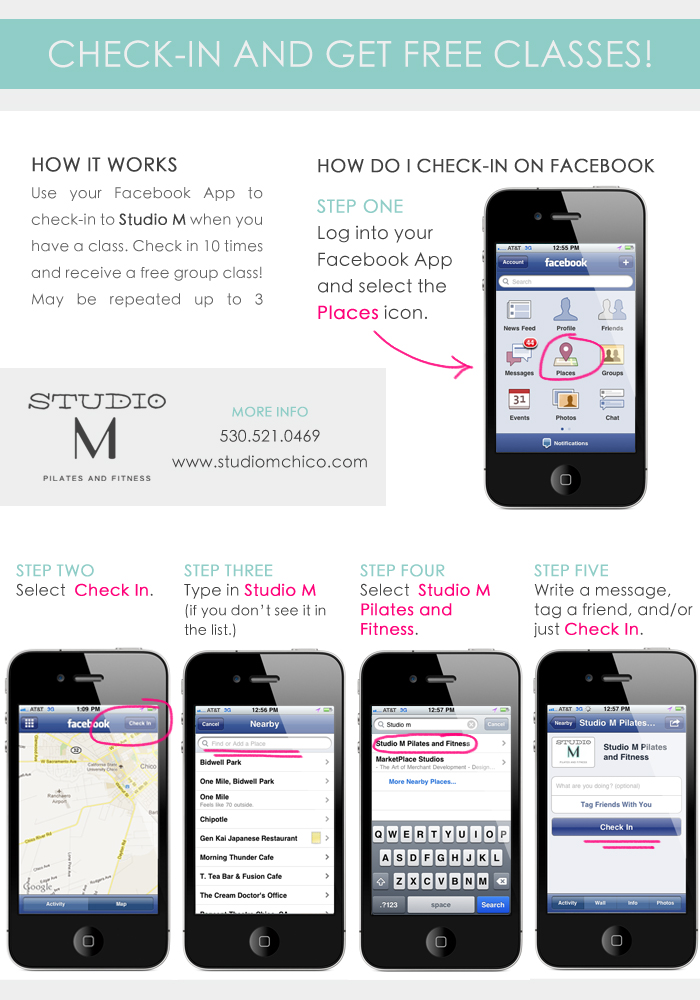

Safe Abdominal Exercises for Pregnancy
What are some safe abdominal exercises for pregnant participants that will help get their bodies ready for labor and delivery?
Strong core muscles are vital for helping prenatal participants offset pregnancy-related postural changes that can cause back pain and other discomforts. The following basic exercises are appropriate for virtually all prenatal and postpartum women. The moves are also excellent for nonpregnant class members who need to learn how to engage their core muscles. Prenatal women should master these exercises before they do any other core or abdominal exercises. Keep the following in mind:
* As with all prenatal exercise, participants must get a physician’s approval before they start.
* Class members should empty their bladders before beginning.
* It is important to maintain neutral spinal alignment (except during the pelvic rock-and-roll). “Neutral” is different for every person and may change as pregnancy progresses.
* If a participant feels discomfort or pain during an exercise, she should stop and be encouraged to discuss her condition with her healthcare provider.
Abdominal Compressions. Perform these moves in seated, standing or quadruped ( all fours) position. In seated or standing position: With spine in neutral alignment and shoulders relaxed, place hands on lower abdomen and let abdomen relax completely. Keeping hands where they are, pull navel toward spine and away from hands while exhaling slowly. Hold contraction, exhale fully, inhale and allow abs to relax back to hands. Do this slowly with the breath, or more quickly, using various music tempos. In quadruped position, perform same maneuver, but work against gravity as abdomen lifts away from floor. Keep shoulders and upper back as still as possible.
Opposite-Arm-and-Leg Horizontal Reach. In quadruped position, tighten abdominal and squeeze glutes. Simultaneously extend one leg and opposite arm parallel to floor. Try to hold body in still, planklike position from fingertips to toes, spine in neutral. Hold for 15–60 seconds and switch sides. In addition to transversus abdominis and obliques, this exercise engages glutes, hamstrings, back extensors and shoulders.
Pelvic Rock-and-Roll. On stability ball, sit up tall and rock hips side to side, causing ball to roll slightly. Do this with control. Continue rocking motion for 30–60 seconds, then tilt pelvis anteriorly and posteriorly, rolling ball front to back for another 30–60 seconds. Shoulders and ribs remain mostly stable without much movement. Adventurous exercisers can also roll ball in a circle, first clockwise then counterclockwise.

Why is my belly not flat when I do my cruches?

Most of us don’t stress about a bit of belly fat hanging over our waistbands during the winter—after all, damage control is just a body-shaping undergarment away. But now you’re headed to a place where not even Spanx can save you: the beach. The frustrating reality is that the midsection is one of the trickiest areas to tone. That’s why even women dedicated to regular exercise often can’t iron out their abs. Fortunately, with expert help, we’ve come up with the ultimate tummy—flattening plan. Not only is it super effective, but it’s likely loads easier than the agonizing ab workouts you’ve been putting yourself through.
Get Flat Abs
Rule #1 – Attack your hidden core muscles
Crunches target only superficial muscles, so they aren’t the most efficient way to work your abs. Hard fact: To burn one pound of fat, you have to do 250,000 crunches, according to researchers at the University of Virginia. That’s 100 crunches a day for seven years. Uh, no thanks.
Instead, you need to target the muscles that lie beneath the superficial ones: your transverse abdominis, multifidis, and internal obliques. Strengthening them pulls in your middle like a corset, keeping the area looking flat and toned. “Not only are these muscles weak in many women, but most of us don’t have a clue about how to engage them,” says celebrity trainer Valerie Waters, whose clients include Jennifer Garner and Elizabeth Berkley.
The core moves here target these “hidden” muscles. To practice engaging them, try this drill from Waters: Lie on your back and place your palms just below your navel. Exhale and allow your tummy to expand as far as you can, then focus on pulling your belly button toward your spine, drawing your abdomen toward the floor. Hold for 5 seconds. Repeat 8 to 10 times.
Rule #2 – Move your butt
Your booty and your belly are unlikely partners in crime. Here’s why: Over time, sitting around too much renders your glutes practically useless and causes your hip flexors—the muscles that connect your hipbones to your legs—to become stiff. This couch-potato combo tilts your pelvis forward, which increases the arch in your back and puts stress on your spine. From a cosmetic standpoint, it pushes your abdomen out, making even a relatively flat stomach bulge. That means that to lose your gut, you’ve got to work your butt.
The glute bridge march and hip-thigh raise will help you get a stronger behind. Combat tight hip flexors with this stretch: In a lunge position, lower yourself so your back knee is resting on the floor. Push your hips forward, keeping your back upright, until you feel a stretch in the front of the hip. Hold for 10 seconds, relax, and repeat. Switch legs. You can increase the stretch by reaching your arms over your head.
Rule #3 – Eat flat-belly foods
You can’t see ab muscles if they’re buried under a layer of fat. Excavate them by following these easy dietary guidelines.
Pump up your protein intake Substituting meat, fish, dairy, and nuts for carbs can reduce the amount of fat around your middle. Researchers at McMaster University in Canada assessed the diets of 617 people and discovered that when they exchanged carbohydrates in favor of an equal amount of protein, they reduced overall belly fat.
Eliminate added sugar The average American eats about 20 teaspoons of sugar daily in the form of processed foods like soda, baked goods, breakfast cereals, fruit drinks, and even flavored yogurt. That’s about 325 empty calories every day. All that sugar increases insulin production, which slows your metabolism.
Don’t fear fat Research shows that diets containing more than 50 percent fat are just as effective for weight loss as those that are low in fat. “Fat is filling and adds flavor to your meals—both of which help you avoid feeling deprived, so you can stick to your diet,” says Alan Aragon, M.S., a nutritionist in the Los Angeles area. Eat foods rich in monounsaturated fats, such as olives, nuts, and avocados; research has even found that it’s OK to enjoy whole foods that contain saturated fat (including milk, cheese, and butter) in moderation.
Beat the bloat No matter how much ab fat you lose or muscle you tone, if you’re bloated, you won’t look (or feel!) your best in a bikini. Carbonated beverages, and even good-for-you foods such as beans and broccoli, can make your stomach swell. And keep your sodium intake in check: Nutritionists suggest you stay under 2,000 milligrams to avoid retaining excess water. (Most of us get closer to 5,000 a day.)
Rule #4 – Stop stressing
Your stock portfolio. Your in-laws. Your never-ending to-do list. We get it—life is hard. But anxiety can produce extra cortisol, a hormone that encourages the body to store fat, particularly in your belly. According to researchers at Yale University, your midsection is four times as likely as the rest of your body to store stress-induced fat. Help keep anxiety in check by taking little breaks from work every 90 minutes. “It’s almost like recalibrating your body—reminding you to breathe and relax,” Waters says.
Another way stress sabotages your abs: When tension runs high, we reach for fattening foods. To keep your hand out of the office candy jar, keep it out of reach. In one study, participants who had to walk six feet to reach the candy ate up to seven fewer chocolates per day than when the jar was conveniently located at their desk.
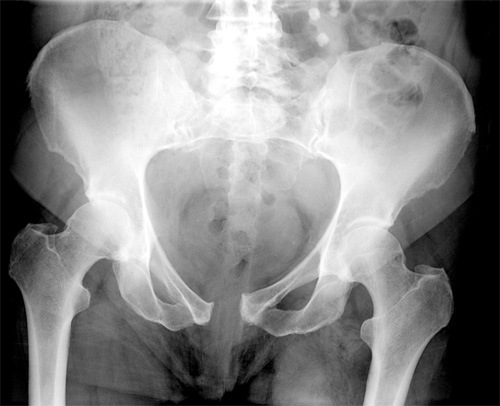
Is your “you-know-what” bothering you? Do you experience discomfort when you, um, well, you know?
Is your you-know-what bothering you? Do you experience discomfort when you, um, well, you know? These women-focused health practitioners know exactly what you mean, and they can help you find relief.
When something’s not right “down there,” it affects how we feel everywhere else. Fortunately, there’s a growing field of medicine devoted to treating these unique complications. Practitioners of women’s health physical therapy help women (and some men) who have problems with sexual intercourse, urination, fertility, pregnancy preparedness, postpartum recovery and cancer recovery. They deal with the stuff we’re too embarrassed to talk about, and because they’ve seen it all, they can reassure patients that their issues are at least treatable, if not always curable.
This specialty started in 1995, when a group of orthopedic physical therapists recognized that their clinics were filling up with women whose concerns weren’t being addressed. Women’s heath physical therapists (WHPT) are often the problem solvers that gynecologists, obstetricians, urologists and other doctors call when confronted with a gender-specific medical mystery, like discomfort during sex, after childbirth or while going to the bathroom. All WHPTs (find one near you by going to the American Physical Therapy Association locator) have stories about patients who were told by a former doctor that their problem was just “part of being a woman.”
Like other types of physical therapists, they specialize in treating functional problems, but they say they also offer proactive services, like helping pregnant women prepare for an easier delivery and preventing complications like C-sections. Here are six situations where a women’s health PT might be able to help you.
Incontinence
“Fifty percent of adult women will have incontinence at some point,” says Jennifer Klestinski, MPT, communications director for the Section on Women’s Health of the American Physical Therapy Association, who has a private practice in Madison, Wisconsin. “Because of anatomic differences, the effects of pregnancy and childbirth, and the effects of decreasing estrogen, women leak far more often than men. But with proper strengthening, the data shows there’s an 85-percent chance of complete resolution.”
The regimen: Weak pelvic muscles are a major factor in incontinence, so in addition to Kegel exercises, Klestinski recommends doubling up: “Engage the pelvic floor muscles while doing other daily core exercises—like Pilates—to strengthen the abs, back and hips.” Another surprising cause is osteoporosis, because a rounded back causes our thoracic cavity and abdomen to press on the bladder. A WHPT would recognize this during an evaluation and could prescribe appropriate exercises for bone density loss.
Make sure you’re practicing Kegels correctly and learn the other pelvic workout you should be doing
Organ Prolapse
Think of prolapse as a hernia that mostly affects women. When the muscles that hold the pelvic organs become weak or stretched, the organs—the bladder, uterus, small bowel, rectum—can drop from their normal spot and push against the wall of the vagina. As many new mothers know, pregnancy is the most common cause of prolapse. However, it’s not just the trauma of the childbirth that’s a factor—it’s also the extra pounds. “There could be 15 to 25 pounds plus the weight of a baby pushing on the perineum,” says Klestinski. This means that excessive weight gain (no baby necessary) can also put you at risk. Weight maintenance is key to avoid risk of prolapse.
The regimen: Klestinski explains how a WHPT would take a holistic approach to address organ prolapse. “We work from the top down and from the bottom up. From above you may have extra body weight and extra downward pressure from poor posture, dysfunctional bladder habits or from adhesions due to prior surgeries or injuries. From the bottom up, we have the pelvic floor muscles, which act as a supportive hammock to the pelvic organs.” Many WHPTs can help women work on weight management through exercise. To further improve the “top down” issues, the therapist would use manual techniques, patient education and posture training. At the other end of the, um, spectrum, she’d put the patient through workouts to strengthen and tone the pelvic muscles. This gives us yet another reason to do those darn Kegels.
Pregnancy and Recovery
Pregnancy causes profound anatomical and hormonal changes to our bodies. “Some women’s bodies accommodate those changes quite well, and some women require a fair amount of work and assistance,” says Jill Boissonnault, WCS, PT, PhD, past president and founder of the International Organization of Physical Therapists in Women’s Health.
The prenatal regimen: Pushing out a baby is never going to be easy, but some WHPTs say that massaging the perineum with a lubricant, as well as stretching the hip and pelvic muscles, can help a woman “open up” during delivery, which could make her less likely to tear. There’s also evidence that pregnant women can be taught how to bulge and flex their pelvic muscles correctly during labor, which can help avoid C-sections.
The postpartum regimen: “There are things a woman can do to mitigate some of the risk for future dysfunction, like strengthening her pelvic floor with Kegels throughout her pregnancy and after she delivers,” says Boissonnault. She adds that in France, where postpartum wellness visits are included under national health coverage, new mothers are likely to be advised by a WHPT about strengthening their pelvic floor muscles, their abs and their posture.
Pelvic Pain
Because many women avoid talking about this with their friends, family members and even their sexual partners, pelvic pain can be emotionally exhausting as well as physically unbearable.
Vulvodynia: An excruciating affliction of the vulva which affects an estimated 16 percent of women at some point in their lives, vulvodynia is described in this video from the Dr. Oz show as feeling like “acid burning the skin” or a “constant, knife-like pain.” It can be caused by trauma to the pelvis, which may result from chronic yeast or bacterial infections, physical force, accidents, surgery, or physical or sexual abuse.
I know a woman in her mid-20s who has suffered from vulvodynia since childhood. She suspects the cause may have had something to do with an ill-fitting waist harness on a forceful carnival ride. In her quest for relief, she was referred to gynecologists, dermatologists and psychologists, and tried topical anesthesia, antidepressants, talk therapy and the patronizing advice to “have a glass of wine and you’ll be fine.” She was finally told that pain-free sex would require surgery, and her doctor advised her to visit a women’s health physical therapist to prepare for the procedure.
“Many doctors assume that women’s health physical therapy can only take you to a certain point,” says my friend’s therapist, Gopi Jhaveri, PT, DPT, co-owner of Brooklyn Health Physical Therapy, “but we know it can take you all the way to recovery.” Jhaveri discouraged the surgery and instead worked with my friend to develop a rehab program. Four months later, my friend joyfully credits Jhaveri with her “cure.”
The regimen: This varies depending on the patient’s anatomy and type and severity of symptoms, but treatment often includes regular in-office manual therapy, at-home stretching using dilators, exercising daily to strengthen the pelvic muscles, avoiding harsh cleansers like soap in favor of sweet almond oil, and using a local anesthetic like lidocaine during sex.
Vaginismus: A 2010 episode of MTV’s True Life featured three women in their 20s whose pelvic conditions prevented them from having intercourse. Tali, an aspiring singer, had a condition called vaginismus, which involves painful, involuntary spasms and tightening of the vagina. As part of Tali’s treatment, Isa Herrera, MSPT, clinical director of Renew Physical Therapy in Manhattan, showed Tali and her boyfriend how to manually stretch Tali’s vagina (it was more clinical than kinky).
Herrera specializes in intra-vaginal massages to release tight or uncooperative muscles, and also in teaching patients and their partners to do this as home. “One out of three women has some sort of pelvic pain,” says Herrera, who is also the author of Ending Female Pain: A Woman’s Manual. However, she says, many women don’t admit it. “I’ve heard excuses like ‘it hurts unless I keep changing positions’ or ‘it hurts because my partner is so big.’ But the vagina is a wonderful thing and should be able to accommodate just about any man.” Herrera says WHPTs empower women to recognize and alleviate their physical discomfort.
The regimen: Techniques vary, but Herrera says she often follows a full pelvic muscle evaluation with manual massage, including trigger-point release technique to “release knots.” Herrera stressed that although the pain may occur in the pelvic area, the most successful approaches are holistic and involve the entire body. “Pain during sex can cause enormous anxiety, which results in the tensing up of different muscles groups, from the pelvis and the legs to the neck and back.” An important aspect of treatment includes diaphragmatic breathing and relaxation techniques to help the patient deal with the anxiety as well as the pain.

The Two Exercises Every Woman Should Be Doing By Corrie Pikul
The Two Exercises Every Woman Should Be Doing
By Corrie Pikul
Oprah.com | August 03, 2011
Women’s health physical therapists swear these pelvic workouts help forestall all kinds of female-specific problems. One’s a classic, and the other will forever change how you look at your watch.
If you have never felt pelvic pain, a “little spritz” (thank you, Whoopi Goldberg, for that phrase), or organ prolapse, you probably want to keep it that way. The best strategy for shaping up “down there”? Yep, that old standby, the Kegel. We know you’ve heard this before, but that’s because experts agree that Kegels are the most effective exercise to improve the muscle tone of the pelvic floor. “After the age of 35, we lose 5 percent of our muscle mass every 10 years,” says women’s health physical therapist Kristi Latham. This reduction occurs in muscles everywhere in the body—including those in our most private regions. Here’s a full pelvic workout, including Kegels and “pelvic clocks.”
Keep in mind: Just like you wouldn’t run sprints with a sprained ankle, you shouldn’t do these exercises if you have a painful pelvic condition (like vaginismus) without first checking with a women’s health physical therapist.
A Kegel Refresher Course
These wonder clenches can increase sexual arousal, improve your ability to reach orgasm, help you master control of your bladder and, says Latham, support your pelvic organs in avoiding dreaded conditions like prolapse.
Fitness instructor: Kristi Latham, PT, CLT, is the pelvic health and lymphedema program director at Metro SportsMed Physical Therapy in Brooklyn, New York.
Warm-up: When you’re just starting out, it’s best to lie down so that you can concentrate solely on your pelvic floor.
The exercise: Squeeze the muscles around your vagina and anus. These are the muscles you use to prevent gas from passing, stop the flow of urine and the muscles that contract during orgasm. Think about trying to pull the muscles up and in (if your pelvic floor is weak, you will only faintly feel this contraction). You’ll know you’re doing these exercises correctly if you feel the muscles tightening but don’t have movement in your abs or buttocks. Isolate your pelvic floor so if somebody looked at you while you were doing the exercise, they wouldn’t think you were moving at all.
The routine: For healthy women without symptoms of pelvic floor impairment, do the following three times per week: 5-second squeeze followed by a 10-second rest period, 10 times, 3 times per day (30 total). With practice, you should be able to do them while sitting at your desk or driving.
Advanced:
Endurance training: Increase hold time and decrease rest time: 10-second squeeze followed by a 3-second rest period.
Sprints: Add in what Latham calls “quick flicks”: Squeeze and relax 5 times, as fast as you can, followed by a 5-second rest period. Do 30 per day, 3 times per week (as above).
Form drills: Try any of the above routines while standing up.
Note: You’ve probably heard that you should practice Kegels by stopping the flow of urine while going to the bathroom. Using Kegels to frequently stop or slow the flow of urine can cause backflow, which creates infection, and can also disrupt your pelvic muscle coordination. Most WHPTs discourage practicing Kegels while urinating. Latham suggests paying attention to how your muscles feel just after urination, then follow up later with a Kegel to feel the difference between relaxed and contracted.
Pelvic Clocks
These exercises can improve circulation to the pelvic organs; decrease tightness, stiffness or congestion from prolonged sitting or standing; increase pelvic flexibility; improve balance and—not enough for you?—help you gain a better awareness of spinal stability.
Fitness instructor: Gail Wetzler, PT, EDO, is the owner of Wetzler Integrative Physical Therapy Center in Newport Beach, California, and instructor of pelvic physical health courses for the American Society of Physical Therapists.
Warm-up: Lie on your back to be sure that the back side of the pelvis has a full range of movement. Bend your knees and keep your feet flat on the floor. Keep your spine in a neutral position. Imagine that there is a clock on your lower abdomen, where 12 o’clock is at the bellybutton, 6 o’clock is at the top of the pubic bone and your hip bones are at 9 and 3.
The exercise: Bring the bellybutton down to the spine. This will make the “clock” tilt, down at the 12 position (bellybutton) and up at the 6 (pubic bone). Move your hip and pubic bones to rotate your clock to the side so that 3 o’clock hip is lower. Move around the clock, tilting the pelvis until the 6 o’clock position is lowest. Continue around the clock, hitting every number, until the 12 position is again the lowest position. Repeat two or three times, then reverse to repeat the cycle in the opposite direction, two or three times.
The routine: For healthy women without symptoms of pelvic floor impairment, the clocks should be done once per day to keep the pelvic girdle in shape. Those experiencing movement restrictions can try these two times per day (a.m. and p.m.).
Advanced: Vary up the routine each day: Try going from 1 o’clock to neutral, then 2 o’clock to neutral, and continuing like that around the clock. Wetzler suggests repeating one movement, such as 4 o’clock to 5 o’clock, five to six times “to really feel the pelvic activity.”
Recent Posts
Categories
- Blog (6)
- Classes (8)
- External Videos (4)
- For Fun (5)
- NeuroKinetic Therapy (1)
- Overall Health (11)
- Pain Management (7)
- Physical Therapy (3)
- Promotions (1)
- Recipes (4)
- Uncategorized (1)
- Weight Loss (11)
- Workshops (2)


